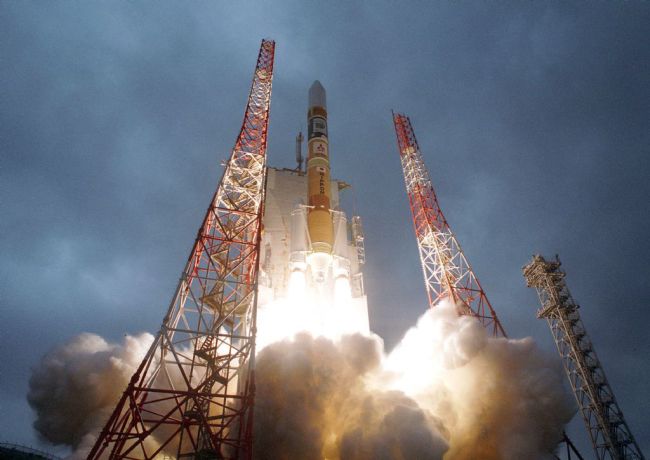| Space: New Japanese Spy Satellites
太空:新的日本间谍卫星 Date:2020-03-02 Source:strategypage By:Globalmil Viewed: |

A file photo of a Japanese H-2A rocket launching a payload into orbit from Japan's Tanagashima Space Center.(Image: © JAXA)
一枚日本H-2A火箭的文件照片,它从日本的田岛太空中心向轨道发射了有效载荷。(图片:©JAXA)
February 25, 2020: On February 9th Japan launched another spy satellite using one of its own H-2A SLVs (satellite launch vehicle). With this new satellite in orbit, Japan has two digital camera photo satellites and five radar satellites operational. Japan is in the process of expanding its spy satellite fleet to ten photo and radar satellites. Japan has long been a major producer of satellites and SLVs but the spy satellites are relatively recent.
2020年2月25日:日本于2月9日使用其自己的H-2A型卫星运载火箭(SLV)发射了另一颗间谍卫星。有了这颗新卫星,日本将拥有两颗数码照相卫星和五颗雷达卫星。日本正在将其间谍卫星编队扩大到十颗照相和雷达卫星。日本长期以来一直是卫星和SLV的主要生产国,但间谍卫星相对而言是最近时期。
Japan launched its first satellite in 1970 and became the fourth nation (after Russia, America and France) to do so. For decades Japan mainly launched scientific satellites. In the late 1990s Japan, alarmed at the threat of attack by North Korea, began developing and launching military satellites. The first two were launched in 2003, the third in 2006 and the fourth in 2007. Japan continues to build and launch photo, radar and ELINT (electronic intelligence) satellites. While Japan buys some launcher and satellite tech from foreign nations (mainly the U.S.), Japan has become quite proficient and self-sufficient in both areas.
日本于1970年发射了第一颗卫星,成为继俄罗斯、美国和法国之后的第四个发射卫星国家。几十年来,日本主要发射科学卫星。在1990年代后期,日本针对朝鲜攻击威胁下,开始研发并发射军事卫星。前两颗是在2003年发射的,日本在2006年发射第三颗,在2007年发射第四颗。日本继续制造和发射照相、雷达和ELINT(电子情报)卫星。日本从外国(主要是美国)购买了一些运载火箭和卫星技术,日本在这两个领域都已变得相当熟练和自给自足。
By 2010 the cameras onboard Japanese photo satellites could make out objects as small as one meter (39 inches) in diameter. By 2013 a new Japanese photo satellite could detect objects .6 meters (two feet) in size. The best U.S. spy satellites can make out much smaller objects, but for Japan's needs, .6-1 meters was adequate. The radar satellites provide all-weather coverage.
到2010年,日本照相卫星上的摄像头可以分辨出小至一米(39英寸)直径的物体。到2013年,新的日本照相卫星可以探测到0.6米(两英尺)大小的物体。美国最好的间谍卫星可以分辨出更小的物体,但对于日本的需求,0.6-1米就足够了。雷达卫星提供全天候覆盖。
Technically, the satellites are in violation of a 1969 Japanese law, which mandated Japan only use space for non-military purposes. To get around this these satellites are technically non-military and are not controlled by the military. Japan had long refrained from launching military satellites but this changed when North Korea fired a ballistic missile over Japan in 1998. Japan promptly set out to get eight surveillance satellites in orbit by 2006, in order to keep an eye on North Korean nuclear weapons and ballistic missile efforts. This proved impossible to do. While two Japanese satellites were launched in early 2003, another two were destroyed during late 2003, when the rocket malfunctioned.
从技术上讲,这些卫星违反了1969年日本法律,该法律规定日本只能将太空用于非军事目的。为避免这种情况,这些卫星在技术上是非军事性的,不受军队控制。日本长期以来一直不发射军事卫星,但是当朝鲜于1998年向日本方向发射一枚弹道导弹。日本迅速着手计划在2006年之前将八枚监视卫星送入轨道,用于监视朝鲜的核武器和弹道导弹。事实证明这不可能做到。虽然日本在2003年初发射了两颗卫星,但在2003年底因为运载火箭发射故障损失了另外两颗。
Japan had long relied on commercial photo satellites and whatever they could get from the Americans. But for high-resolution shots, on-demand, of North Korea, and electronic eavesdropping from space, they needed their own spy satellites. It is believed that Japanese spy satellites are also being used to watch military developments in China and Russia.
日本长期以来一直依靠商业摄影卫星以及它们从美国人那里得到的一切。但对朝鲜按需要拍摄高分辨率照片以及从太空进行的电子窃听,他们需要自己的间谍卫星。据认为,日本间谍卫星也被用来监视中国和俄罗斯的军事发展。
The Japanese program has cost over three billion dollars so far. Much of this was spent to develop SLVs large and reliable enough for satellite work. The latest launch was the 35th successful launch for the H-2A, which has a 97.5 percent success rate. The similar H-2B SLV has carried out ten successful launches. Japanese SLVs have put nearly a
hundred satellites into orbit since 1970. Most have been non-military and several were for other nations. Japanese SLVs are locally designed and manufactured. These rockets operate from a launch complex in southern Japan.
到目前为止,日本计划已耗资超过30亿美元。其中大部分用于开发大型SLV,足够可靠地进行卫星作业。最新的发射是H-2A型第35次成功发射,该运载火箭的成功率百分比是97.5。类似的H-2B SLV已经成功进行了十次发射。日本的SLV自1970年以来,将100颗卫星载入轨道。大多数是非军事性的,还有一些是其他国家的。日本SLV由本国设计和制造。这些火箭从日本南部的发射场运行。
The two-stage H-2A was first used in 2001. It was originally a 285 ton rocket that could put 10 tons into orbit. Later versions of the H-2A weighed up to 445 tons with a max payload of 15 tons. The H-2B variant weighs 531 tons and can put 16.5 tons into orbit.
两级H-2A型于2001年首次使用。它最初是285吨的火箭,可以将10吨的载荷送入轨道。后来的H-2A重达445吨,最大有效载荷为15吨。 H-2B型重531吨可以入轨16.5吨的载荷。
A new SLV, the 574 ton H-3 is in development and close to entering service. The first test launch will be in 2020. The H-3 will specialize in putting satellites in high orbits. Because of the breakthroughs American firm SpaceX has made with their reusable (they land under their own power after launch) rockets, Japan is now working on an H-4 SLV
that would have that feature.
新的574吨H-3型SLV正在开发中,即将投入使用。首次测试将于2020年启动。H-3将专门用于将卫星送入高空轨道。由于突破,美国SpaceX公司拥有了可重复使用的火箭(发射后由其自行控制着陆),日本目前正在研发H-4 SLV将具有该功能。
The Japanese photo satellites weigh about a ton, while the radar one weighs about a third more. The United States provided a lot of technical assistance on the design and construction of the satellites initially and Japan now builds its own rockets to launch them. Like most spy satellite users, Japan does not report on how effective they are. It is known that Japan could get more detailed photos from commercial satellites. But those are not controlled by the Japanese government.
日本的照相卫星重约一吨,而雷达重约三分之一。美国在最初和现在向日本提供了有关卫星设计和制造的大量技术援助,日本制造自己的火箭来发射它们。与大多数间谍卫星用户一样,日本没有报告他们的效果如何。众所周知,日本可以从商业卫星获得更详细的照片。但是那些不受日本政府控制。
上一篇:Electronic Weapons Trial By Sensor Fusion 下一篇:Air Defense Lasers For Low, Slow And Tiny Threats
| The Booker dilemma: inside US Army transformation
“布克”困境:美国陆军转型内幕 |
| The decision to cancel the M10 Booker light tank is at the core of a reordering of US Army planning.... [2025-07-16] |
| Focus: A fragile balance in Asia, China has become leading military power in the
焦点:亚洲平衡脆弱,中国已成为该地区的主要军事力量 |
| However, China's rapid military growth in this area is tipping the balance in favor of regional power. ... [2024-08-27] |
| Small drones will soon lose combat advantage, French Army chief says
法国陆军总司令表示,小型无人机将很快失去战斗优势 |
| By Rudy Ruitenberg Thursday, Jun 20, 2024 作者:鲁迪瑞滕伯格 2024年6月20日星期四 French Army Chief of Staff Gen. Pierre Schill inspecting a Rapid Eagle anti-drone system at the Eurosatory defense show in Paris on June 19, 202... [2024-08-18] |
| What’s next for Ukraine’s incursion into Russia?
乌克兰入侵俄罗斯的下一步是什么? |
| Ukraine’s forces have surprised us all with its recent incursion into Russia’s Kursk Oblast since the operation to turn the tide of the war,... [2024-08-17] |
